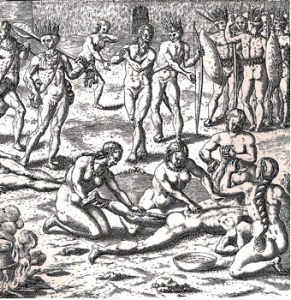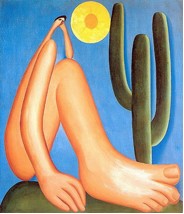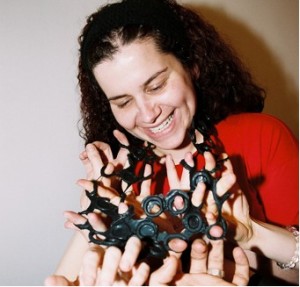I’ve just recently read the interesting text of Marta Carmelo in Art Jewelry Forum giving voice to the Mexican jewelers and how the Gray Area Symposium has came up with new concepts and proposals for the local contemporary jewelers. I’ve read texts of Europeans that came home and were also questioning themselves about the ways we are positioning ourselves in the market/artworld, etc. As the one of the two Brazilian lecturers of the event, I would also give my input about it as well in this new series of post that I’ll be writing.
First I would like to introduce you to the concept of anthropophagy and how it is strictly related to Brazilian identity.
According to Ana Maria Belluzo in her book “O Brasil dos Viajantes” the first images of America date from the XVI century. As she says, the name America derives from Americo Vespuccio and also reflects the wish to overcome its legendary state. Beyond the Atlantic everything was a legend, so the testimony of travelers acquired the state of truth and its images were seen as evidences.

One of the most important among these travelers is Hans Stade. The image we see is related to him and it describes a ceremony of Brazilian indians eating another human being: anthropophagy.
A very shocking image for these days if you focus your attention on the indian’s hairstyles and accessories, not to mention their Renaissancentist body structure…One can see since how long images can manipulate and fake ideas can be created.
His reports also dating from the XVI century would turn out into a sort of legend around here. Staden in his first-person narrative confesses his fears, premonitions and even tells he lies, leaving all the truth of the report in doubt. The ambiguity of his text creates a tension between the reality experienced by him (he was capture by a tribal and even treated as their pet) and the fictional description that involves the reader. This narrative would influence all the imagery about Brazil and would be the basis of the modernist book Macunaima of Mario de Andrade.
Andrade was a key figure in the modernist art movement that took place in Brazil in the first half of the XX century. The movement also counted with other writers and artists who were engaged in finding a national artistic identity. Most of them had studied in Europe, having had contact with the artistic avant-gardes. Coming back to Brazil they started to create theories and manifests that were the result of a mix: the European influences, Indian native and African ones. The result of this mix did not kept the original characteristics of the European influence, it was more an appropriation of the foreigner fused with national characteristics leading to a strong distortion. This artistic approach was called anthropophagic. The influences were eaten, digested and expelled into something different. It was their solution to the issue of cultural dependency.

As an example, one of the strongest images of this period is Tarsila do Amaral’s painting, Abaporu.
Why am I mentioning all these in a jewellery site? Well, the reason is that I see somehow a similar moment happening in Brazilian jewellery scene. Coming back from Gray Area Symposium we could realize that all Latin American speakers, as myself, have been abroad to study: so the first ingredient of the formula is there. Also, many of Latin American jewellery creators, confronted with this foreigner influence have come back to their roots in order to find their own creative expression. I believe now we are arriving at a second stage: a broader contamination of other national jewellery creators.
Although we have evident efforts such as Otro Diseño’s, Metalísteria and more recently NOVAJOIA’s actions, I believe an important element that is missing are schools devoted to teach Art Jewellery. I use the word devote because it demands a restless effort. As an example, after 2 years of trials, NOVAJOIA finally got its Art Jewellery courses proposals accepted by two Art Colleges. We are very excited with this opportunity of spreading the ideas we believe. We will probably have the availability of an institutional space to receive artists from abroad and increase interchange.
In these days where a single testimony do not turn out into lasting legends, where information can be more easily reached, we should communicate frequently and interact more, but not only virtually.
It is not only good for the emerging markets as ours, but as for the established ones since they are also going towards saturation and an excess of competition. As a relatively small group of creators, art jewellery makers should join globally to spread more actively their ideas and pieces, helping to create new poles of interest globally.
I leave you with the idea that participation and involvement could make the future perspectives better. In my opinion, Gray Area proved so.

Longing for the Body, 2005, photographer: André Penteado


